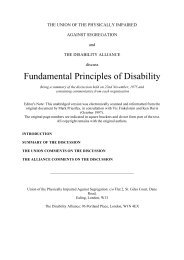Global-Report-Living-Colour-dr2-2
Global-Report-Living-Colour-dr2-2
Global-Report-Living-Colour-dr2-2
You also want an ePaper? Increase the reach of your titles
YUMPU automatically turns print PDFs into web optimized ePapers that Google loves.
Inclusive Communities = Stronger Communities<br />
GLOBAL REPORT ON ARTICLE 19: THE RIGHT TO LIVE AND BE INCLUDED IN THE COMMUNITY<br />
119<br />
moved to community options while those with more<br />
significant challenges were often relocated to other<br />
institutional settings such as nursing homes,<br />
rehabilitation centres or other similar long term care<br />
facilities.<br />
We know that deinstitutionalization is not a simple matter<br />
of closing a facility and moving residents to the<br />
community. To be successful and sustainable, the process<br />
must involve careful individual and systems level planning.<br />
Additional community based supports must often be<br />
created and/or expanded to support those returning to<br />
community as well as those who are already in community<br />
(usually with families). Adequate and appropriate support<br />
must be provided to both individuals and families. Full<br />
consideration must be given to ensuring that individuals<br />
become full and participating members of their<br />
community and not have simply exchanged one<br />
institutional setting for another that is merely different in<br />
size and location. Self-advocates from across the world<br />
have told us that life in community – inclusion in<br />
community – is possible only if it comes with the ability to<br />
make choices, take risks and have control.<br />
As countries complete their deinstitutionalization efforts,<br />
continue to close existing facilities and/or begin to<br />
consider the merits of initiating such a process, there are<br />
several emerging and ongoing challenges that must be<br />
addressed.<br />
‰ Other Institutional Settings<br />
Stories told to us by families and self-advocates,<br />
particularly in countries where traditional institutions<br />
specifically for people with intellectual disabilities<br />
have been closed reveal an increasing trend of using<br />
other institutional placements as an acceptable<br />
option. In countries such as Canada, the USA, Japan,<br />
New Zealand, Australia and the UK families and self<br />
AUSTRALIA There are a variety of<br />
lessons learned – eg. people<br />
invariably live better lives, families<br />
often resist the move, government<br />
commitment is influenced primarily<br />
driven by the cost, it is harder to<br />
develop individual alternatives than<br />
group ones (e.g. group homes).<br />
INDIA “Our students sometimes<br />
come from home with nothing: no<br />
school equipment or basic necessities.<br />
We are starting to keep chickens and<br />
grow vegetables so we can improve the<br />
children’s diet and help them stay<br />
healthy.”<br />
One young boy at the school adds: “I<br />
like to board at the school because<br />
there I have a bed with a proper<br />
mattress. We play with children from<br />
the mainstream classes at break<br />
times.” His friend, a young girl, adds:<br />
“I would even prefer to stay at<br />
weekends too.” Their parents reported<br />
being pleased that their children were<br />
now in school, where they are learning<br />
more than they were at home, and they<br />
do not have to travel so far each day.



